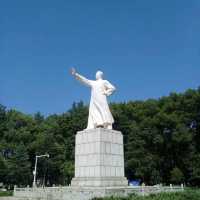The Confucian Temple of Fuxue in Jinan was founded in the Song Dynasty (1068-1077 AD) and located on the Bank of Daming Lake. History has been destroyed and rebuilt several times. During the Jin Dynasty, the Confucian temples of Fuxue were severely damaged by the war and collapsed at the end of the Yuan Dynasty. In the second year of Hongwu in Ming Dynasty (1369 AD), in the nineteenth year of Chenghua (1483 AD), it was rebuilt for several generations. By the end of Ming Dynasty, the architectural layout had been perfected. In Qing Dynasty, the renovation of Confucian temples continued, but basically kept the size and architectural layout of Confucian temples in Ming Dynasty, making the area of Confucian temples in Fuxue reach Minghu Road in the north, Gongyuan Wall Gen Street in the west, Gongyuan Wall Gen Street in the south, Qushuiting Street in the east. The Confucian Temple of Fuxue in Jinan was the center of Jinan culture and education in the past dynasties, but after the abolition of the imperial examination in the Republic of China, the Confucian Temple of Fuxue gradually declined. Because of years of war, the Confucian Temple of Jinan Prefecture had been destroyed before liberation. After liberation, Dacheng Hall was once built as an auditorium. Later, the Confucian Temple of Fuxue became the primary school building of Daming Lake Road. Since September 10, 2005, the Fuxue Confucian Temple in Jinan, which has been carefully repaired for five years, has been completed in full on September 28, 2010. Jinan Fuxue Temple, located at 214 Daminghu Road, Jinan City, is an important existing government-level temple in China. Its main building, Dacheng Hall, situated in the north and south, is the largest single ancient building in Jinan City. According to historical records, the Confucian Temple of Fuxue in Jinan was originally a huge building complex, with a total length of 247 meters and a width of 64 66 meters. The whole complex is symmetrically deployed along a central axis. The momentum of the year can still be dimly distinguished from the preserved four buildings, namely, the shadow wall, the South Gate, Panchi and Dacheng Hall. From south to north, the pattern of the Confucian Temple is in turn the main buildings such as Nanmen, Zhongru Pavilion, Foxing Gate, Panchi, Pingmen, Hall (commonly known as Dacheng Gate), Dacheng Hall, Eastern and Western Corridors, Minglun Hall, Zunjing Pavilion and so on. The two divisions inside the South Gate are: quot; regular Pavilion " round shape, meaning " without rules, square circle " admonishing Confucian students to have a rigorous attitude in learning. However, the whole Jinan Fuxue Confucian Temple, unlike other places, is not in the South and North direction, but in a curved shape, which is relatively rare in the Confucian Temple, and may be related to the geographical environment when the Confucian Temple was built at that time. Jinan Confucian Temple has a great feature is its Panchi, not only big Panchi, but also small Panchi, which is relatively rare in the temple. In addition, Panchi in other places is mostly just a symbol, and some can only put in some dead water at most. And Panchi here has not only water, but also flowing spring water, which is extremely rare in the country, if not unique. This fully demonstrates that Jinan has developed its water system in history and embodies its characteristics as a spring city. Panchi's spring water flows from Furong Street in the south. It flows into the big and small Panchi through open channel and dark channel. Then it flows into Qushuiting Pavilion through the Yudai River and then into Daming Lake. This time, they cooperated with the maintenance works, excavated and restored the previous waterways. In this way, visitors to the Confucian Temple can not only get the influence of Confucian culture, but also experience the characteristics of Jinan spring culture. Fold
;
Jinan Fuxue Confucian Temple Review
4.6 /557 Reviews
Popular Destinations
Washington D.C. Travel | Bodrum Travel | Larnaca Travel | Taipei Travel | Amman Travel | Dubai Travel | Watford Travel | Sunderland Travel | Phi Phi Islands Travel | Koh Samui Travel | Albufeira Travel | Da Nang Travel | Marseille Travel | Crewe Travel | Kettering Travel | Sorrento Travel | Dar es salaam Travel | Thiruvananthapuram Travel | Milos Travel | Dengfeng Travel | Curacautin Travel | Ararat Rural City Travel | Dennis Port Travel | Shaoxing Travel | Giverny Travel | Klamath County Travel | Kronshtadt Travel | Mae Fa Luang Travel | Volterra Travel
Recommended Attractions at Popular Destinations
Bangkok attraction near me | Tokyo attraction near me | Manila attraction near me | Hong Kong attraction near me | Seoul attraction near me | Taipei attraction near me | Los Angeles attraction near me | New York attraction near me | Shanghai attraction near me | Kuala Lumpur attraction near me | Shenzhen attraction near me | Osaka attraction near me | London attraction near me | Singapore attraction near me | Guangzhou attraction near me | San Francisco attraction near me | Beijing attraction near me | Macau attraction near me | Bali attraction near me | Paris attraction near me | Orlando attraction near me | Ho Chi Minh City attraction near me | Jakarta attraction near me | Chicago attraction near me | Phuket attraction near me | Toronto attraction near me | Dallas attraction near me | Cebu attraction near me | Istanbul attraction near me | Seattle attraction near me
Popular Attractions
Yunnan Ethnic Village | Seine River Cruise | Guangzhou Chimelong Tourist Resort | Windsor Castle | Aquaria KLCC | The Bund | Universal Studios Japan | Nami Island | Bosphorus | Yu Garden | Wat Arun Ratchawararam Ratchawaramahawihan | Universal Beijing Resort | London Eye River Cruise | Jade Dragon Snow Mountain | Lake Como | Columbia Pictures Aquaverse | Battersea Power Station | Kuala Lumpur Tower | Nanjing Road Pedestrian Street | St Michael's Mount | Cabo Finisterre | Masjid Al Furqan | Tsukinokiekinishi Sango Park | VAULTBOY - Live in Singapore | St. Reweis Coptic Orthodox Church | Praça do Estrela | McLoughlin Prom | park | Aventura Nautica Barcelona | Masjid Al-Muttaqin Desa Buluh Patah
Popular Travelogues
Bangkok Travelogue | Tokyo Travelogue | Hong Kong Travelogue | Seoul Travelogue | Los Angeles Travelogue | New York Travelogue | Shanghai Travelogue | Kuala Lumpur Travelogue | Shenzhen Travelogue | Osaka Travelogue | Singapore Travelogue | London Travelogue | Guangzhou Travelogue | San Francisco Travelogue | Beijing Travelogue | Macau Travelogue | Bali Travelogue | Paris Travelogue | Ho Chi Minh City Travelogue | Phuket Travelogue | Chicago Travelogue | Toronto Travelogue
Payment Methods
Our Partners
Copyright © 2024 Trip.com Travel Singapore Pte. Ltd. All rights reserved
Site Operator: Trip.com Travel Singapore Pte. Ltd.
Site Operator: Trip.com Travel Singapore Pte. Ltd.






























